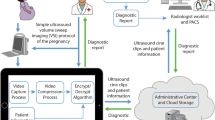Abstract
Teleradiology was utilized to link an offsite, high-risk nursery to the Department of Pediatric Radiology of Children's Hospital of Michigan. Interpretations via teleradiology were made in 4200 examinations and taken as the final reading. There was no expansion of either professional or technical personnel at either hospital to accomplish these ends. During the initial 3 months of the study, 40% of the teleradiographic images were double-read to evaluate the accuracy of the technique. During the subsequent 9 months, 17% of the cases were double-read, for an overall double-reading of 23%. There was a 98% agreement between the interpretations made using teleradiology and those made using hard copy. In no instances of the 2% (20 cases) in which there was disagreement between readings did the difference have clinical significance. Our results indicate that teleradiology linkage for interpreting neonatal examinations serves as a valuable tool for expansion of subspecialty expertise, allows more expedient recognition of abnormalities in the neonate, and facilitates faster transport to the appropriate tertiary care center.
Similar content being viewed by others
References
Gitlin JN (1986) Teleradiology. Radiol Clin North Am 24: 55
Franken EA, Driscoll CE, Berbaum KS, Smith WL, Sato Y, Steinkraus LW, et al. (1989) Teleradiology for a family practice center. JAMA 261: 3014
Szafran AJ, Kropf R (1988) Strategic uses of teleradiology. Radiol Manage 10: 23
Kagetsu NJ, Zulauf DRP, Ablow RC (1987) Clinical trial of digital teleradiology in the practice of emergency room radiology. Radiol 165: 551
Kuhn JP, Seidel FG (1987) Digital teleradiography in a neonatal intensive care unit. 73rd Scientific Assembly, Radiological Society of North America
Lear JL, Manco-Johnson M, Feyerabend A, et al. (1989) Ultra-high-speed teleradiology with ISDN technology. Radiol 171: 862
DiSantis DJ, Cramer MS, Scatarige JC (1987) Excretory urography in the emergency department: utility of teleradiology. Radiology 164: 363
Markivee CR, Mahanta B, Savci S, et al. (1989) Diagnostic accuracy of a teleradiology image transmission system. MD Computing 6: 88
Author information
Authors and Affiliations
Rights and permissions
About this article
Cite this article
Slovis, T.L., Guzzardo-Dobson, P.R. The clinical usefulness of teleradiology of neonates: expanded services without expanded staff. Pediatr Radiol 21, 333–335 (1991). https://doi.org/10.1007/BF02011480
Received:
Accepted:
Issue Date:
DOI: https://doi.org/10.1007/BF02011480




